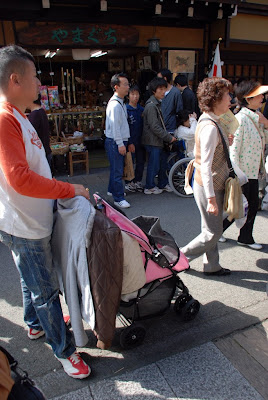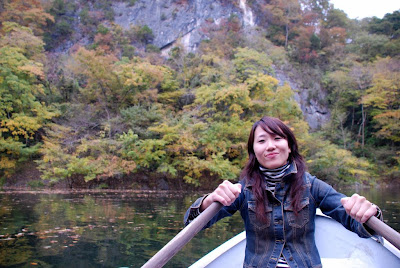岐阜県での冒険
Gifu Prefecture Adventure
Saturday, 11th - Monday, 13th October 2008
Naomi and I made the 500km trip by car from Hiroshima to Gifu Prefecture, home to Japan's world heritage listed Shirakawa-go and the nearby beautiful town of Takayama. The trip took just under 8 hours one way using the highway from Hiroshima Prefecture costing just over 10,000 yen (AUD150).
The Tokai-Hokuriku highway runs from the Nagoya area and new sections have opened recently to traffic making the trip there fairly easy. There are some 54 tunnels that make up the highway one being 11km long - the longest tunnel I have ever driven through!
Shirakawa-go is known for it's world heritage listed thatched roof buildings which date back to the 18th century. The town has resisted modern development and has an attractable and unique atmosphere. There are dozens of the traditional houses scattered around the town. They are also run as bed & breakfast inns.
We stayed the night at Kanja, a family run inn with a handful of rooms separated by paper thin sliding doors called fusuma. If you're a light sleeper than the snoring coming from the rooms beside yours may keep you up! The couple in the middle and the two guys standing on the right were guests and we all had a good old chat over dinner and breakfast. In the morning we all went our separate ways.
this a picture of our room. While you are eating dinner in the dining room, the children run down the corridor dragging the futons for each of the guests to their rooms which are made up when you return! It's all part of the gassho-zukuri experience.
this is myozenji-kyodokan (Myozen Temple - folk museum). Inside you can marvel at the architecture of the gassho-zukuri house. On display are various types of tableware that were once used as well as agricultural machines and tools.
This is an irori - Japanese for fireplace which played a couple of important roles in the house. One of course being for the preparation of food. The other an innovative technique using the rising heat to warm up the upstairs area. Shirakawa-go is located up in the mountains close to the Japan Sea. In winter the cold Arctic air that flows in from the north bringing with it sub zero temperatures and heavy snow fall make this an important and essential item for the house!

this is the breakfast served at the gassho-zukuri house. Rice, miso soup, kousouyaki (local food - miso, onion & mushroom), dried seaweed, pickles and a raw egg!

the house in the background in called Wadake. It is probably the most well known of the gassho-zukuri houses and is often the subject of many photographs. You can see it standing out clearly in the first photo of this entry. The house dates back to the Edo period and is still used today as a residential property. It is also listed as in important cultural property. Visitors are able to enter and get a feel for what life would have been like living in such a place.

Naomi's best shot!

this is the upstairs floor of the house where you can see the rafters that support the thatched roof. According to the owners of the inn that we stayed at, the roofs which are made from straw are replaced every 30 years and up to one hundred town folk help out to re-fit an entire roof! There are photographs of this exercise taking place in the houses and I must say it is quite a sight!

This cabinet houses silk worms which produce raw silk that was sold to generate an income for the household

a short drive north of Shirakawa-go finds oneself in Toyama Prefecture which is also the home to various heritage listed gassho-zukuri sites. This above photo shows Gokayama (五箇山) which Naomi and I decided to visit before heading to Takayama. It was a pleasant place to visit, still full of tourists but also had its own unique atmosphere.

me caught on camera taking a photo!

this is a traditional gassho-zukuri shed used to house farming equipment

a photo of the village itself. All gassho-zukuri houses are occupied
we had a refreshing cup of macha - Japanese powdered green tea with some local dango - Japanese dumplings


Takayama is about a 40 minute drive from Shirakawa-go and is well known for its old streets. Most of the buildings have been restored from the Edo and Meiji periods. There are many Japanese sake factories present. You can often see a sugitama hanging above the entrance way which is a symbol that new sake has been produced and is on sale.
While walking around the town of Takayama in the early evening we happened to pass this little workshop. The craft work caught my eye and we stopped to have a look. This craftsman spends his days carving mainly owls of all sizes from a special local wood. The technique he uses is called ichibori in Japanese. The craftsman said that the smaller owls take him a few hours to carve out but the larger ones can take up to two or three days. Naomi bought me a pair of the small ones. These owls are said to bring good luck.

these people are lining up to buy the famous koroke - deep fried potato - but these ones are special because they have hida beef in them! Naomi and I had one each!

like most things deep-fried it was yummy!
most people use a pram to push their children around however.......
take a look in the pram and tell me what you can see!


Dogs in Japan seem to get treated like humans! Over the years that I have been here in Japan I have come across many people who are fanatical about dogs, especially tiny house dogs that their owners spend more than I spend on food in a month on dog clothes, hair trimming and accessories including the pram above! On this trip we noticed a dozen or so people pushing dogs around the place in comfy looking prams treating them out for the day! The wind was a little chilly so the dog blankets kept them warm too!
Hida beef is a famous product in the area. This is raw hida beef sushi! I wasn't sure at first but the meat basically melted in my mouth once I bit into it! It was delicious but too expensive to make a habit of eating it!

this is one of the many stalls that can be found in the Takayama morning markets. You can find locally produced goods and locally grown vegetables and fruit sold directly by the farmers themselves. It was a pity we were over 500km away from home!

The day we arrived in Takayama, we went for a 4km stroll around the town and on the way down from Shiroyama (literally castle mountain ) we passed this attractive looking tea house. It was too late to stop at that time so we returned the next morning for a coffee.

the coffee came out on Japanese china and we also enjoyed some local sweets made from soy beans coated in sugar.





















